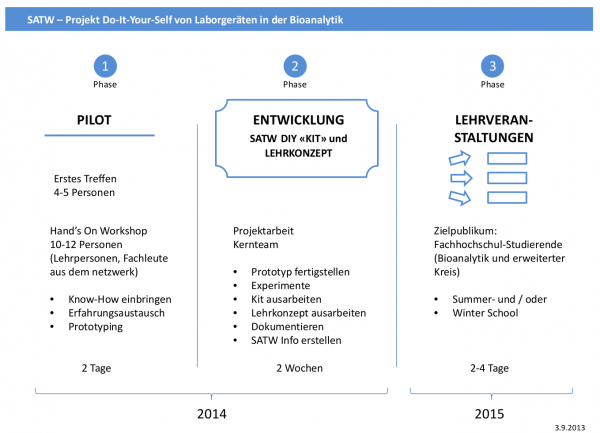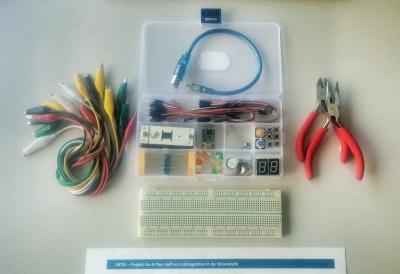SATW - Do-it-yourself von Laborgeräten in der Bioanalytik
Contents
Overview
Co-Development of a workshop on DIY laboratory instruments for bioanalytics, colorimetry, low-cost microcontrollers and simple DIY electronics, enzymatic assays. With a concept of "teach the teachers", we are looking into DIY lab-tools as means of a pedagogic tool for interdisciplinary thinking at the biomedical/engineering/molecular interface. Coproduced with SATW, Swiss Academy of Technical Sciences, Hackteria and FHNW, School for Lifesciences.
Team
Coaches
- Dani Gygax, FHNW
- Marc Dusseiller, hackteria
- Urs Gaudenz, HSLU / hackteria
Weitere potentielle Teilnehmer
- Rüdiger Trojok, openbioprojects / synergenen / hackteria
- Eric Kübler, FHNW
- Silvio Dinardo, HLSU
- Laura Suter-Dick, FHNW
- Andreas Thommen, FHNW-students
- (Alexancdre de Spindler), ZHAW
- EPFL? Sachiko? Renaud? ?
- LAPASO netzwerk? dresden? oder studi?
!!! Wir sollten noch weitere leute aus anderen Schulen mit dabei haben!
Teach-the-Teachers Workshop
Tentative Date: 9-10. July 2014
Overview
- Was ist Do-it-Yourself
- Einführung in Elektronik, LED, Licht-Sensoren, Messtechnik
- Prototyping
- Konzepte der Bioanalytik
- Isolieren und anwenden eines Enzyms (Phosphatase aus Kartoffeln)
- Test des DIY-Colorimeters mit Mikrokontroller - Vergleich mit dem DIY-Prototyp
- Diskussion und Feedback zu den Lehrkonzepten
- Ausblick
Project Plan
SATW-DIY Kit
http://www.appropedia.org/Open-source_Lab
http://openlabtools.eng.cam.ac.uk/
A final Quote
"There is a growing realization that innovation processes do not automatically follow from the results of research, whatever their potential may be. The “linear model,” which foresees that basic research will somehow find its way to being transferred or translated into applied research, which will in turn later appear on the market in the form of commercially viable products or processes, appears as an idealized version of what happened in a given historical period, namely, after World War II. Nor can today’s innovation processes be left to entrepreneurs alone, however strong their “restlessness” (in a Schumpeterian sense) may be. The omnipresent quest for innovation, caught up as it has been in a globalized world, is a hybrid of many elements. It includes the availability of venture capital, and the creativity of determined individuals as much as the flexibility of institutions and regulatory processes".
- Helga Nowotny, The Quest for Innovation and Cultures of Technology, 2006
https://www.berghahnbooks.com/books/freepdfs/NowotnyCultures_intro.pdf

